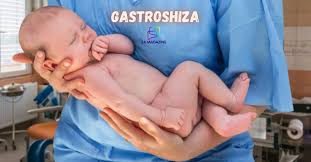1. What is Gastrochisis? An Overview
Gastrochisis is a rare congenital defect where a baby is born with the intestines protruding through a hole in the abdominal wall, usually to the right of the umbilicus. Unlike other abdominal wall defects, such as omphalocele, gastrochisis does not involve a protective sac covering the exposed organs, making them vulnerable to damage and infection.
This condition typically develops early in fetal life, often between weeks 5 and 8 of pregnancy. The exposed intestines are at risk of inflammation and other complications due to constant contact with amniotic fluid. Understanding gastrochisis is essential for early diagnosis and effective treatment planning.
2. Causes and Risk Factors of Gastrochisis
The exact cause of gastrochisis remains unknown, but researchers believe it may result from a disruption in blood flow to the developing abdominal wall during pregnancy. This interruption may prevent proper closure of the abdominal muscles, allowing the intestines to protrude outside the fetus’s body.
Certain risk factors have been linked to a higher likelihood of having a baby with gastrochisis. These include young maternal age (especially mothers under 20), smoking during pregnancy, use of certain medications, and poor prenatal nutrition. While genetics do not appear to play a major role, environmental factors are suspected to contribute significantly.
3. Signs and Symptoms of Gastrochisis in Newborns
Gastrochisis is typically visible at birth, with the infant’s intestines exposed and extending outside the body through a small opening near the umbilicus. The bowel often appears thickened, swollen, and inflamed due to exposure to amniotic fluid during gestation.
In addition to visible bowel protrusion, infants with gastrochisis may experience difficulty feeding, failure to gain weight, or signs of intestinal obstruction. Although the condition is usually not associated with other anomalies, early diagnosis is crucial to reduce complications and initiate timely surgical intervention.
4. Diagnosing Gastrochisis During Pregnancy
Gastrochisis is most commonly diagnosed during routine prenatal ultrasounds, often as early as the second trimester. The ultrasound can reveal the protruding intestines and confirm the absence of a surrounding sac, which helps differentiate gastrochisis from other abdominal wall defects.
Further diagnostic tools, such as fetal MRI or advanced 3D ultrasound, can provide more detailed imagery to assess the extent of the condition. Elevated levels of alpha-fetoprotein (AFP) in maternal blood tests may also signal the presence of an abdominal wall defect, prompting further evaluation.
5. Treatment Options for Gastrochisis
Treatment for gastrochisis involves surgical repair to return the exposed intestines to the abdominal cavity and close the defect. In cases where the intestines are severely swollen or damaged, a staged repair may be necessary, utilizing a silo bag to gradually reposition the organs over several days.
Post-surgical care is essential and often requires a neonatal intensive care unit (NICU) stay. Babies are closely monitored for infection, bowel function, and nutritional needs. Long-term outcomes largely depend on the severity of the defect and any associated complications, but many infants recover well with proper care.
6. Surgical Techniques Used in Gastrochisis Repair
There are two primary surgical approaches for treating gastrochisis: primary closure and staged closure. In primary closure, the exposed bowel is returned to the abdomen in one surgery, and the abdominal wall is sutured shut. This is preferred when the abdominal cavity can safely accommodate the bowel.
In cases of significant swelling or insufficient space in the abdominal cavity, a staged repair is done using a silo—a sterile pouch that encloses the exposed intestines and allows for gradual reduction over several days. Once the organs are reintroduced into the abdomen, the wall is surgically closed, often with favorable outcomes.
7. Complications Associated with Gastrochisis
Despite advances in surgical care, gastrochisis can lead to a range of complications. The most common include intestinal atresia (narrowing or blockage), necrotizing enterocolitis (tissue death in the intestines), and short bowel syndrome, which can result from surgical removal of damaged segments of the intestine.
Infections, delayed feeding, and slow weight gain are other concerns during recovery. Long-term digestive problems may persist in some cases, requiring nutritional support or additional surgeries. Early intervention and close medical monitoring are critical to minimizing these risks.
8. Prognosis and Long-Term Outcomes
The prognosis for infants with gastrochisis has improved dramatically over the past few decades, with survival rates now exceeding 90% in developed countries. Outcomes are best when the condition is isolated and treated promptly after birth.
Long-term, many children experience normal growth and development, although some may face challenges related to digestion or feeding. Continued follow-up with pediatric surgeons and gastroenterologists is recommended to monitor health and address any ongoing issues as the child grows.
9. Preventive Measures and Prenatal Care
While gastrochisis cannot always be prevented, certain lifestyle choices during pregnancy may help reduce the risk. Avoiding smoking, drug use, and exposure to harmful environmental toxins are key preventative measures. Adequate nutrition and prenatal vitamins, including folic acid, are also recommended.
Early and consistent prenatal care allows for timely detection of fetal anomalies like gastrochisis. Women at higher risk may benefit from targeted screenings and closer monitoring throughout pregnancy to ensure the best possible outcomes for both mother and baby.
10. Living with Gastrochisis: Support and Resources for Families
Families facing a gastrochisis diagnosis often experience emotional and financial stress. Connecting with support groups and organizations dedicated to congenital birth defects can provide valuable guidance and reassurance during this challenging time.
Hospitals with specialized neonatal surgical units offer multidisciplinary care teams, including social workers, dietitians, and therapists, to assist with the child’s medical and developmental needs. Parental education and access to resources empower families to make informed decisions and advocate effectively for their child’s health.
If you need this


